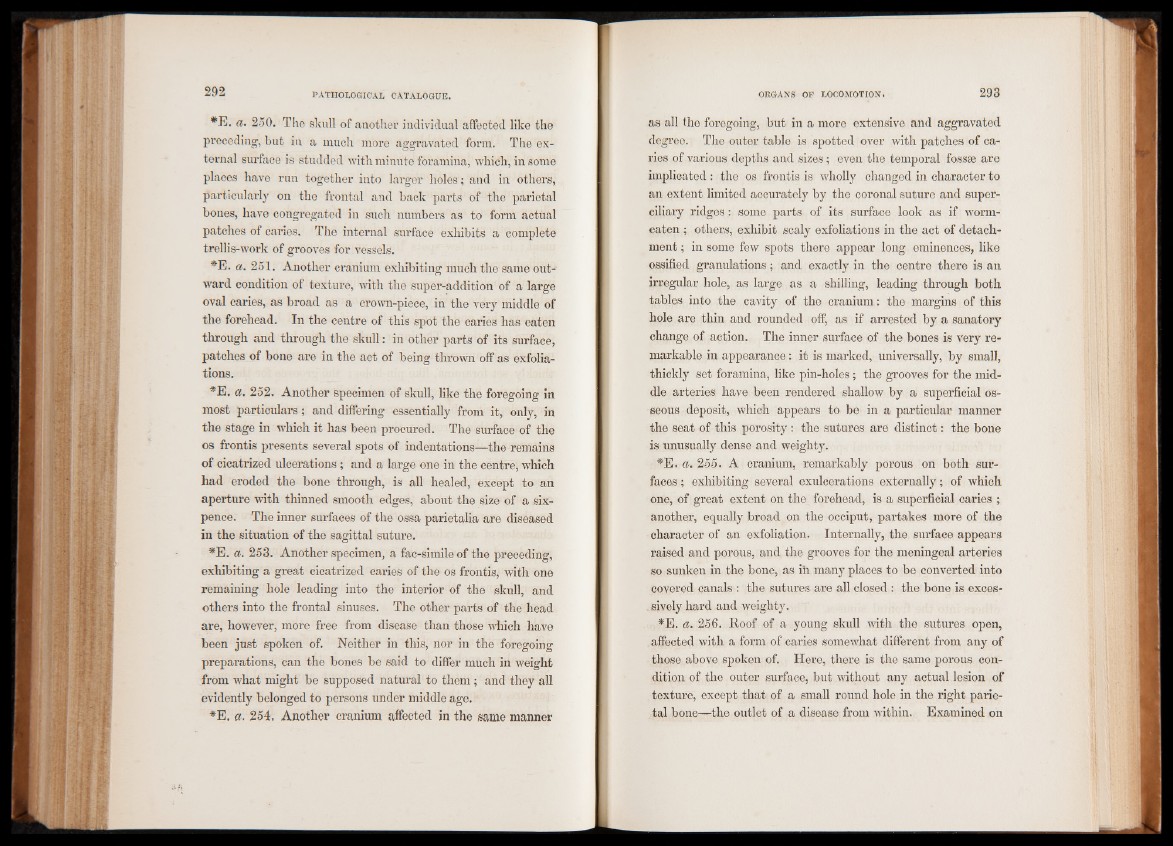
#E. a. 250. The skull of another individual affected like the
preceding, but in a much more aggravated form. The external
surface is studded with minute foramina, which, in some
places have run together into larger holes; and in others,
particularly on the frontal and back parts of the parietal
bones, have congregated in such numbers as to form actual
patches of caries. The internal surface exhibits a complete
trellis-work of grooves for vessels.
*E. a. 251. Another cranium exhibiting much the same outward
condition of texture, with the super-addition of a large
oval caries, as broad as a crown-piece, in the very middle of
the forehead. In the centre of this spot the caries has eaten
through and through the skull: in other parts of its surface,
patches of bone are in the act of being thrown off as exfoliations.
*E. a. 252. Another specimen of skull, like the foregoing in
most particulars; and differing essentially from it, only, in
the stage in which it has been procured. The surface of the
os frontis presents several spots of indentations—the remains
of cicatrized ulcerations ; and a large one in the centre, which
had eroded the bone through, is all healed, except to an
aperture with thinned smooth edges, about the size of a sixpence.
The inner surfaces of the ossa parietalia are diseased
in the situation of the sagittal suture.
*E. a. 253. Another specimen, a fac-simile of the preceding,
exhibiting a great cicatrized caries of the os frontis, with one
remaining hole leading into the interior of the skull, and
others into the frontal sinuses. The other parts of the head
are, however, more free from disease than those which have
been just spoken of. Neither in this, nor in the foregoing
preparations, can the bones be said to differ much in weight
from what might be supposed natural to them; and they all
evidently belonged to persons under middle age.
*E. a. 254. Another cranium affected in the same manner
as all the foregoing, but in a more extensive and aggravated
degree. The outer table is spotted over with patches of caries
of various depths and sizes; even the temporal fossae are
implicated : the os frontis is wholly changed in character to
an extent limited accurately by the coronal suture and superciliary
ridges: some parts of its surface look as if worm-
eaten ; others, exhibit scaly exfoliations in the act of detachment
; in some few spots there appear long eminences, like
ossified granulations; and exactly in the centre there is an
irregular hole, as large as a shilling, leading through both
tables into the cavity of the cranium: the margins of this
hole are thin and rounded off, as if arrested by a sanatory
change of action. The inner surface of the bones is very remarkable
in appearance: it is marked, universally, by small,
thickly set foramina, like pin-holes; the grooves for the middle
arteries have been rendered shallow by a superficial osseous
deposit, which appears to be in a particular manner
the seat of this porosity : the sutures are distinct: the bone
is unusually dense and weighty.
*E. a. 255. A cranium, remarkably porous on both surfaces
; exhibiting several exulcerations externally; of which
one, of great extent on the forehead, is a superficial caries ;
another, equally broad on the occiput, partakes more of the
character of an exfoliation. Internally, the surface appears
raised and porous, and the grooves for the meningeal arteries
so sunken in the bone, as ih many places to be converted into
covered canals : the sutures are all closed : the bone is exces-
. sively hard and weighty.
*E. a. 256. Roof of a young skull with the sutures open,
affected with a form of caries somewhat different from any of
those above spoken of. Here, there is the same porous condition
of the outer surface, but without any actual lesion of
texture, except that of a small round hole in the right parietal
bone—the outlet of a disease from within. Examined on